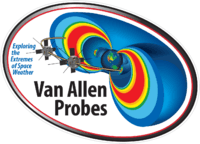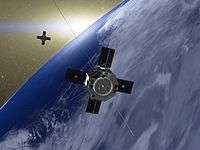Van Allen Probes
|
Van Allen Probes in space | |
| Names | Radiation Belt Storm Probes |
|---|---|
| Mission type | Astrophysics |
| Operator | NASA |
| COSPAR ID | 2012-046A and 2012-046B |
| SATCAT № | 38752 and 38753 |
| Website | http://vanallenprobes.jhuapl.edu/ |
| Mission duration |
Planned: 2 years Elapsed: 4 years, 3 months and 23 days |
| Spacecraft properties | |
| Manufacturer | Applied Physics Laboratory |
| Launch mass | ~1500 kg for both |
| Start of mission | |
| Launch date | 30 August 2012, 08:05 UTC |
| Rocket | Atlas V 401 |
| Launch site | Cape Canaveral SLC-41 |
| Contractor | United Launch Alliance |
| Orbital parameters | |
| Reference system | Geocentric |
| Regime | Highly elliptical |
| Semi-major axis | 21,887 km (13,600 mi) |
| Perigee | 618 km (384 mi) |
| Apogee | 30,414 km (18,898 mi) |
| Inclination | 10.2° |
| Period | 537.1 minutes |
 | |
The Van Allen Probes (formerly known as the Radiation Belt Storm Probes[1] (RBSP)) are two robotic spacecraft being used to study the Van Allen radiation belts that surround Earth. NASA is conducting the Van Allen Probes mission as part of the Living With a Star program.[2] Understanding the radiation belt environment and its variability has important practical applications in the areas of spacecraft operations, spacecraft system design, mission planning and astronaut safety.[3] The probes were launched on 30 August 2012.
Overview
NASA's Goddard Space Flight Center manages the overall Living With a Star program of which RBSP is a project, along with Solar Dynamics Observatory (SDO). The Applied Physics Laboratory is responsible for the overall implementation and instrument management for RBSP. The primary mission is scheduled to last 2 years, with expendables expected to last for 4 years. The spacecraft will also work in close collaboration with the Balloon Array for RBSP Relativistic Electron Losses (BARREL), which can measure particles that break out of the belts and make it all the way to Earth's atmosphere.[4][5]
The Radiation Belt Storm Probes mission is part of NASA’s Living With a Star program, which is managed by Goddard Space Flight Center in Greenbelt. The Johns Hopkins University Applied Physics Laboratory (APL) manages the mission and is building and will operate the Van Allen Probes for NASA.
Milestones
- Mission concept review completed, 30–31 January 2007[6]
- Preliminary design review, October 2008
- Confirmation review, January 2009
- Probes transported from Applied Physics Laboratory in Laurel, Maryland to Cape Canaveral Air Force Station in Florida, 30 April 2012
- Probes launched from Space Launch Complex-41 at Cape Canaveral Air Force Station in Florida on 30 August 2012. Liftoff occurred at 4:05 a.m. EDT.[7]
Launch vehicle
On 16 March 2009 United Launch Alliance (ULA) announced that NASA had awarded ULA a contract to launch RSBP using an Atlas V 401 rocket.[8] NASA delayed the launch as it counted down to the four-minute mark early morning on 23 August. After bad weather prevented a launch on 24 August, and a further precautionary delay to protect the rocket and satellites from Hurricane Isaac, liftoff occurred on 30 August 2012 at 4:05 AM EDT.[9]
Science

The Van Allen radiation belts swell and shrink over time as part of a much larger space weather system driven by energy and material that erupt off the Sun's surface and fill the entire Solar System. Space weather is the source of aurora that shimmer in the night sky, but it also can disrupt satellites, cause power grid failures and disrupt GPS communications. The Van Allen Probes will help scientists to understand this region and to better design spacecraft that can survive the rigors of outer space.[2] The mission is to gain scientific understanding of how populations of relativistic electrons and ions in space form or change in response to changes in solar activity and the solar wind.[2]
The mission's general scientific objectives are to:[2]
- Discover which processes - singly or in combination - accelerate and transport the particles in the radiation belt, and under what conditions.
- Understand and quantify the loss of electrons from the radiation belts.
- Determine the balance between the processes that cause electron acceleration and those that cause losses.
- Understand how the radiation belts change in the context of geomagnetic storms.
In May 2016, the research team published their initial findings, stating that the ring current that encircles Earth behaves in a much different way than previously understood.[10] The ring current lies at approximately 10,000 to 60,000 km (6,200 to 37,000 miles) from Earth. Electric current variations represent the dynamics of only the low-energy protons. The data indicates that there is a substantial, persistent ring current around the Earth even during non-storm times, which is carried by high-energy protons. During geomagnetic storms, the enhancement of the ring current is due to new, low-energy protons entering the near-Earth region.[10][11]
Scientific results

In February 2013, a third temporary Van Allen Radiation Belt was discovered by using data gathered by Van Allen Probes. The said third belt lasted a few weeks.[12]
Spacecraft

The Van Allen Probes consists of two spin-stabilized spacecraft that were launched with a single Atlas V rocket. The two probes must operate in the harsh conditions they are studying; while other satellites have the luxury of turning off or protecting themselves in the middle of intense space weather, the Van Allen Probes must continue to collect data. The probes have, therefore, been built to withstand the constant bombardment of particles and radiation they will experience in this intense area of space.[2]
Instruments
Because it is vital that the two craft make identical measurements to observe changes in the radiation belts through both space and time, each probe will carry the following:
- Energetic Particle, Composition, and Thermal Plasma (ECT) Instrument Suite ; The Principal Investigator is Harlan Spence from University of New Hampshire. Key partners in this investigation are LANL, Southwest Research Institute, Aerospace Corporation and LASP
- Electric and Magnetic Field Instrument Suite and Integrated Science (EMFISIS); The Principal Investigator is Craig Kletzing from the University of Iowa.
- Electric Field and Waves Instrument (EFW); The Principal Investigator is John Wygant from the University of Minnesota. Key partners in this investigation include the University of California at Berkeley and the University of Colorado at Boulder.
- Radiation Belt Storm Probes Ion Composition Experiment (RBSPICE); The Principal Investigator is Lou Lanzerotti from the New Jersey Institute of Technology. Key partners include the Applied Physics Laboratory and Fundamental Technologies, LLC .
- Relativistic Proton Spectrometer (RPS) from the National Reconnaissance Office
See also
- Balloon Array for RBSP Relativistic Electron Losses (BARREL)
- Cassini–Huygens
- Cluster II (spacecraft)
- Heliophysics
- Solar Dynamics Observatory
- Solar and Heliospheric Observatory
- STEREO (Solar TErrestrial RElations Observatory)
- TIMED (spacecraft)
- WIND (spacecraft)
References
- ↑ "Van Allen Probes: NASA Renames Radiation Belt Mission to Honor Pioneering Scientist". Reuters. Science Daily. 11 November 2012. Retrieved 12 November 2012.
- 1 2 3 4 5 "RBSP - Mission Overview". NASA. 28 March 2012. Retrieved 8 July 2012.
- ↑ Radiation Belt Storm Probes (RBSP)
- ↑ Karen C. Fox (22 February 2011). "Launching Balloons in Antarctica". NASA. Retrieved 13 July 2012.
- ↑ Balloon Array for RBSP Relativistic Electron Losses
- ↑ "Construction Begins!". The Johns Hopkins University Applied Physics Laboratory. January 2010.
- ↑ "Probes launched".
- ↑ "United Launch Alliance Atlas V Awarded Four NASA Rocket Launch Missions". ULA. 16 March 2009.
- ↑ "Tropical Storm Isaac Delays NASA Launch". The Brevard Times. Retrieved 26 August 2012.
- 1 2 Cowing, Keith (19 May 2016). "Van Allen Probes Reveal Long-term Behavior of Earth's Ring Current". Space Ref. Retrieved 20 May 2016.
- ↑ Gkioulidou, Matina; et al. (19 May 2016). "Storm time dynamics of ring current protons: Implications for the long-term energy budget in the inner magnetosphere". Geophysical Research Letters. doi:10.1002/2016GL068013. Retrieved 20 May 2016.
- ↑ "Ephemeral third ring of radiation makes appearance around Earth" Nature.com. Retrieved: 2 March 2013.
External links
| Wikimedia Commons has media related to Radiation Belt Storm Probe. |
- NASA Van Allen Probes mission page
- Johns Hopkins APL Van Allen Probes mission page
- The Van Allen Probes on Twitter

- Hi-res spherical panoramas in the clean room before encapsulation for launch



